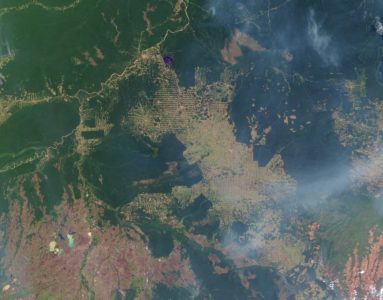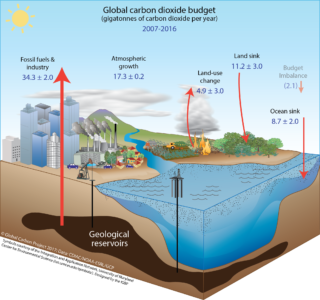In Defense of Live Carbon
Why Stopping Deforestation May be the Hardest and Most Important Part of the Climate Change Challenge

When contemplating the enormous challenge of global climate change, it is sometimes helpful to think about a simple model of the global carbon budget (see figure below). These admittedly reductionist schematics distinguish between sources, sinks, and reservoirs. Fossil hydrocarbons from the geological reservoir–call this dead carbon—are extracted and burned to generate energy, emitting vast amounts of CO2. At the same time, deforestation and land use change convert some of the carbon in the terrestrial reservoir—call this live carbon—into CO2. All of that CO2 then ends up in one of three places: the atmosphere, the oceans, or the terrestrial biosphere.
For most of human history, the destruction of live carbon through deforestation and land use was the largest sources of anthropogenic CO2 emissions. Starting in the middle of the twentieth century, as the great acceleration began, the use of dead carbon for energy has been the largest source of CO2 emissions, accounting for about 85% of global CO2 emissions in recent years.

According to the latest report from the Global Carbon Budget, which provides data through 2017, land use change (mainly tropical deforestation) accounted for about 13% of total carbon emissions (1.5 billion tons of carbon or about 5.5 billion tons of CO2) and 30% of the sink (with the oceans providing another 23% of the sink and the atmosphere absorbing the remainder).
Given these relative contributions, climate policy has often given forests short shrift, making use of the reductionism in global carbon budgets and treating live carbon and dead carbon as equivalent. Because of the large contribution that fossil hydrocarbons make to global CO2 emissions, the argument goes, we should focus our attention first and foremost on energy-related emissions (primarily the power sector and transportation). And given the momentum in the energy system, and the committed emission embodied in all of the trillions of dollars of fixed capital that make up the global energy system, accelerating the transition to a clean energy system should be our number one priority when it comes to fighting climate change.
But this view rests on a set of misconceptions. First, live carbon and dead carbon are not equivalent. A ton of live carbon left in the terrestrial biosphere is more valuable (for both climate and non-climate reasons) than a ton of dead carbon left in the geological reservoir. This is obvious in the case of the ongoing sequestration capacity of forests because that ton of live carbon will continue to grow and sequester carbon over time. A moment’s reflection, along with mountains of evidence, also reveals all of the other environmental, economic, social, and cultural benefits that come from protecting forests.
Second, its actually harder to protect forests and reduce emissions from deforestation and land use than it is to reduce emissions from the energy sector. This is where some parts of the forest advocacy community have made a mistake. By emphasizing that forests can be a near-term mitigation opportunity—that reducing emissions from deforestation is fast, easy, and cheap as one early report on the matter put it, these advocates and analysts have created the impression that this is the easier part of the climate change challenge. In effect, forest protection provides a “land bridge” to the main event: reducing emissions from the energy sector.
In fact, it now looks like just the reverse is true. Although progress in decarbonizing the power sector has slowed a bit recently, we have made enormous strides over the last several decades. Innovations and cost reductions in renewable power generation, storage, electric vehicles, and energy efficiency are scaling (faster than expected in some cases). And the very fact that they can scale—and reinforce each other—is what makes them different from forests and land use. As we decarbonize the power sector and start to electrify transportation and other sectors of the economy, we can actually see an end game of dramatically reduced dead carbon emissions. To be sure, this may not happen for any number of reasons. My point is that it is easier to see the pathway and that we seem to be moving along that pathway (albeit too slowly).
With forests and land use, it is much harder to see the pathway. Similar economies of scale do NOT appear to hold in the forest and land use sector. The old adage that they aren’t making any more land is true—a fact that often translates into a zero-sum logic when one looks at competing demands for arable land for energy, food, carbon sequestration, and all of the environmental services that come with healthy intact forests and terrestrial ecosystems. And when we add climate disruption on top of this, things get bleak.
If you read the recent IPCC report on 1.5 degrees carefully, you will see that it identifies the importance of forests and land use as a central part of any climate solution, as do various declarations, statements, and scientific papers. The forthcoming report on climate change and land—planned for release later this summer—should help to raise the profile of the land question in the context of climate change.
But the “climate solutions” framing of forests and land use sometimes slips back into a set of assumptions that this is the easier part of the climate change challenge. Thus, forests and land use are often held out as part of a portfolio of “natural climate solutions” that, according to recent estimates, could help achieve 37 percent of the climate target needed to keep global warming below 2 degrees Celsius (3.6 degrees Fahrenheit). One recent report refers to forests as the forgotten solution to climate change, emphasizing that forests could provide 30% of the solution to climate change needed by 2030 and that these “natural climate solutions are affordable, scalable and available right now.” And for more than a decade, various consultants and other high-level policy reports have pointed to cost estimates of various GHG abatement options (witness the once ubiquitous McKinsey cost curve) suggesting that reducing deforestation is a relatively cheap abatement option when compared to replacement of fossil-based energy systems with new technologies.
To be sure, since the early 2000s, there is hard evidence that deforestation can be dramatically reduced. For a variety of reasons, only some of which were connected to climate policy, Brazil reduced the rate of deforestation in the Brazilian Amazon by more than 70% between 2005 and 2016 even as it increased production of soy and beef. This is arguably the most important climate change success story of the last several decades. But no one should take the Brazil experience for granted. The progress made in reducing deforestation is fragile and could easily be lost in the years ahead.
Which brings us to the third misconception about live carbon: Politics. The politics around land use are often more intense and difficult than those around energy. And the politics around land in some of the most important tropical forest countries are going in the wrong direction, making forest protection that much harder. Brazil’s new President, Jair Bolsanaro, has embraced the same anti-science, climate denial agenda as President Trump and other right-wing ideologues seeking or taking power around the world. Since his election, Bolsonaro has ditched plans to host key UN climate talks next year and appointed a foreign minister who believes that climate change is a Marxist plot. On the first day of his Presidency, Bolsonaro launched an assault on indigenous land rights and made clear that protecting the Amazon is not part of his agenda. Brazil’s own homegrown version of the tea-party—a potent mix of evangelicals, agribusiness, and the extractive sector—has given rise to the Bacanda Ruralista—an increasingly powerful voting bloc in the Brazilian Congress and the source of much of Bolsonaro’s power. Environmental and other civil society groups are being targeted. And the federal government is pursuing an active policy of rolling back protections for the Amazon, speeding up development, and “assimilating” indigenous peoples.
Early indications suggest that deforestation is on the rise in Brazil, driven not only by Bolsonaro’s policies but also by the collateral effects of the US-China trade war on Chinese sourcing of soybeans. Looking beyond Brazil, the numbers on global deforestation over the last couple of years are sobering: An update from Global Forest Watch last month showed that the world lost an area of primary tropical rainforest roughly equivalent to the size of Belgium (3.6 million hectares). Brazil had the highest loss of area of primary forest loss (1.3 million hectares), followed by the Democratic Republic of Congo (481,248 hectares), Indonesia (339,888 hectares), and Colombia (176,977) hectares. Overall, 2018 saw the third highest loss of primary tropical rainforests (after 2016 and 2017) since 2002. One bright spot in the data: primary forest loss in Indonesia was down significantly for the second year in a row.
A recent study published in Science assessing the drivers of tree cover loss between 2001 and 2015 concluded that commodity-driven deforestation accounted for 27 percent of all forest loss, followed by forestry (26 percent), shifting agriculture (24 percent), and wildfire (23 percent).
And the challenge is not just in the tropics. The devastating recent fires here in California illustrate the growing vulnerability of live carbon in temperate regions as climate change accelerates. As these forests burn, people die. Others lose their homes and businesses. Still others suffer from dramatic spikes in air pollution. And more greenhouse gases are emitted. The camp fire alone released GHG emissions equivalent to all GHGs from the state’s transportation sector for an entire week. Taken as a whole, total emissions from the 2018 wildfire season in California were estimated at roughly 68 million tons of CO2, about the same as a year’s worth of emissions from California’s entire electricity sector.
Here is the thing. If we go back to the distinction between live carbon and dead carbon that I made at the beginning of this post, then it should be clear that live carbon is much more precious and valuable than dead carbon. While it is undeniably true that a ton of CO2 has the same climate impact once it is emitted regardless of the source or location (“a ton is a ton is a ton” as they say), it is also undeniably true that the co-benefits associated with keeping a ton of live carbon in the ground far exceed the co-benefits of keeping a ton of a dead carbon in the ground.
My contention here is that forests and land use are likely to turn out to be the most important, but also the hardest, part of the climate change challenge, and that this may be what kills us in the end.
To be clear, we should be doing everything we can to reduce emissions on both fronts—and, yes, we should also be focusing on other GHGs like industrial gases. But in a world of triage and tragic choices—and that is the world we are in when it comes to climate change—we should stop thinking about climate change as primarily an energy problem and we should think long and hard before we privilege reductions in the energy sector over those from forests and land use.
Some will surely point to all that fixed capital invested in the global energy system, and the problem of carbon lock-in that comes from investing in new energy infrastructure dedicated to fossil hydrocarbons. I get it. I have written about that very problem on this blog. The momentum in the global energy system creates enormous challenges. And current patterns of investment are not encouraging, given that last year close to $1 trillion (60% of total investment in the global energy system) was invested in new assets dedicated to the production, transport, processing, and conversion of fossil hydrocarbons. But we can—and often do—devalue fixed capital. In fact, we are already seeing substantial devaluation of coal plants in the U.S. power sector in the face of cheap natural gas and renewables. Devaluation is never easy, and it would be far better to avoid building fossil assets in the first place, but devaluation can and does happen in the power sector. If I had to choose, I would rather have the option to force early retirement of fossil fuel plants than allow further destruction of tropical forests. Once those forests are destroyed, they are effectively lost to us forever. And if we lose tropical forests, we face ecological collapse—even before the worst effects of climate change take hold.
Reader Comments
One Reply to “In Defense of Live Carbon”
Comments are closed.







It is worth noting that land forests are not the only forests. Macroalgae (kelp) forests may be a more important potential carbon sink than trees because of their rapid growth.
It is also worth noting that significant kelp forests were destroyed by human intervention as well; hunting sea otters for their fur rendered them nearly extinct. Unfortunately, otters were the main protector of kelp forests from predation by sea urchins, which ate the base or holdfast, killing the plant. Restoration of sea otters and hence natural kelp forests to their original range might sequester a significant fraction of the carbon emitted by coal fired utilities. We are not absolutely sure of all that is required to restore sea otters, but California residents can donate to projects working on this on their tax returns.
More negative carbon dioxide emissions would be possible by artificial kelp farming, especially if the kelp is not used for biofuel and in deep water (which increases the proportion and permanence of sequestration). The other advantage of kelp farming is that it does not compete with food farming for resources such as land and fresh water and there are a number of projects looking at this. (Kelp as a cattle feed also reduces methane produced by cattle as well as emissions caused by conventional agricultural practices.) There are significant engineering challenges with greatly expanded deep water kelp farming, however.
One other note is that the reason coal exists is because at the beginning of the Carboniferous age, trees evolved lignin, which bacteria did not evolve to metabolize until the end of that age (which is why it ended). Hence wood was buried and became coal instead of being metabolized back to carbon dioxide. This is no longer the case, though biological metabolysis of wood is still difficult, so trees do not represent a very long term (100’s of millions of years) carbon sink, though hopefully long enough to get through the next century or so.